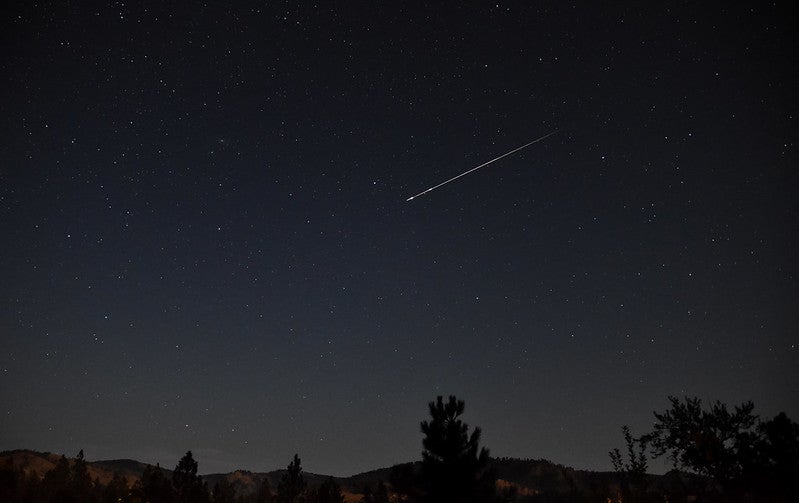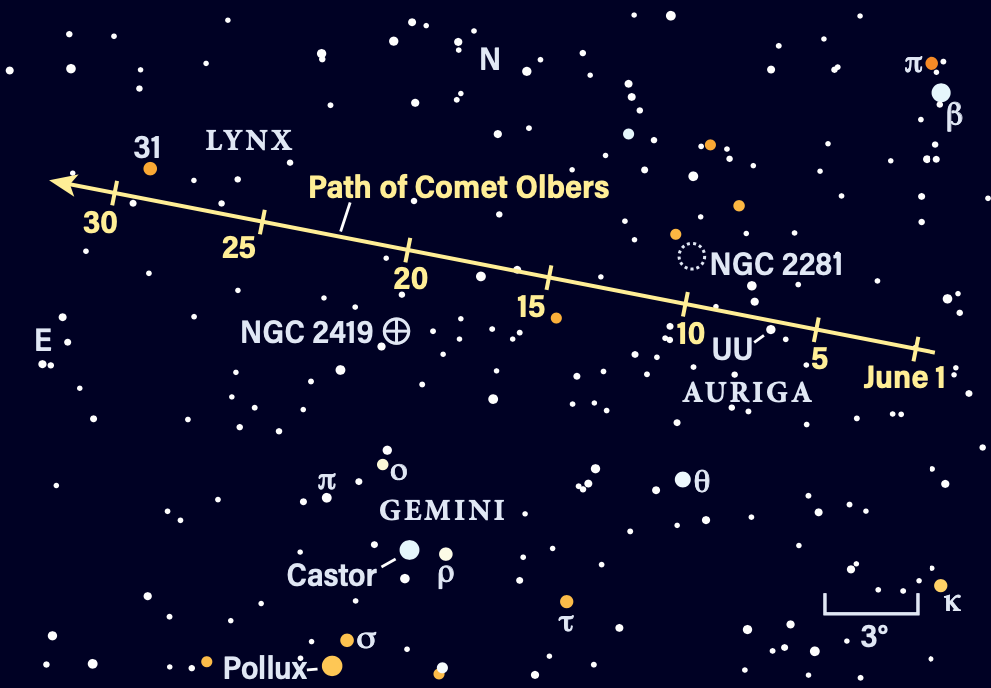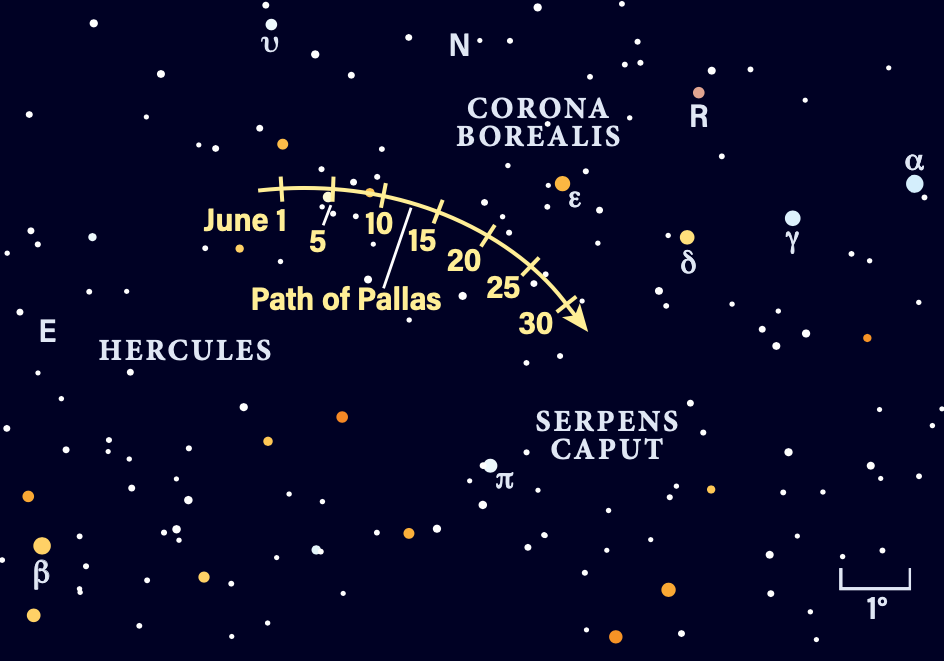
Friday, June 7
Although the next major meteor shower — the Southern Delta Aquariids — doesn’t hit until next month, our skies are never completely meteor-free. Sporadic meteors are those that appear randomly and aren’t associated with any particular comet or subsequent shower. On average, about five to seven of these might appear per hour, streaking across any part of the sky. That’s about one every 10 minutes or so.
Of course, because sporadic meteors are random there’s no guarantee that you will or won’t see a given number per hour. Additionally, as with meteor showers, the rate is an average, so you might see two in quick succession, then none for quite some time. Because they can appear anywhere — as opposed to coming from the direction of a particular constellation — the best way to see such meteors is simply to scan the sky at regular intervals with your naked eyes. Binoculars and telescopes significantly reduce the amount of sky you can see at any given time, thus similarly reducing the chance of spotting a sporadic meteor.
As a bonus, the 2024 noctilucent cloud season has begun! These silvery night-shining clouds, also called NLC, are another night-sky wonder you can see with the naked eye, and aren’t the same as the fluffy, dark clouds that obscure your view of the heavens. So, if you’re out late looking for meteors, keep an eye on your northern horizon as well for a potential NLC display.
Sunrise: 5:31 A.M.
Sunset: 8:27 P.M.
Moonrise: 6:04 A.M.
Moonset: 10:15 P.M.
Moon Phase: Waxing crescent (2%)
*Times for sunrise, sunset, moonrise, and moonset are given in local time from 40° N 90° W. The Moon’s illumination is given at 12 P.M. local time from the same location.
Saturday, June 8
With several naked-eye planets in the morning sky this month, the fainter ice giants can go a little overlooked. But Uranus — within easy reach of binoculars — sits near an easy and popular naked-eye target, the Pleiades cluster of stars in Taurus. Cataloged as M45, these stars are spread over an area about four times as large as the Full Moon. The brightest six to nine stars — depending on your eyesight and viewing conditions — form a shape not unlike a tiny dipper, though not to be confused with the much larger Little Dipper in the north.
An hour before sunrise this morning, the Pleiades are still low, about 3° high in the east. If they’re visible above your horizon, however, pull out a pair of binoculars and slide about 7.1° southwest to reach the location of Uranus, the second-to-last planet from the Sun.
The ice giant is currently magnitude 5.8 and spans nearly 3.5″ on the sky — tiny, but you may be able to identify that it appears “flat” and disklike, rather than a pointlike star. It lies close to the border of Taurus, which also holds the Pleiades, and Aries, which currently contains no planets — but give it a few days. First-magnitude Mars, which is now in Pisces and visible to the naked eye, will cross into Aries by the 10th.
Meanwhile, Uranus will continue to share Taurus with Jupiter, currently magnitude –2 and rising about 50 minutes before the Sun. Throughout the month, the giant planet will continue to pull away from our star, rising earlier and earlier and becoming increasingly more visible in the pre-dawn hours as part of June’s ongoing parade of planets.
Sunrise: 5:31 A.M.
Sunset: 8:27 P.M.
Moonrise: 7:05 A.M.
Moonset: 11:04 P.M.
Moon Phase: Waxing crescent (6%)
Sunday, June 9
Look south this evening to spot Scorpius the Scorpion as he extends his mighty claws up toward Libra the Balance. Scorpius’ brightest star is Antares, which shines at magnitude 1 and is the 15th-brightest star in the sky. Its deep red color, visible to the naked eye, comes from its temperature, about 3,600 kelvins (6,000 degrees Fahrenheit or 3,300 degrees Celsius, as opposed to the Sun’s 10,000 F or 5,600 C). Although Antares is cooler than our star, it is much more luminous — by some 10,000x! It is also much more massive, with over 10 times the mass of our star.
Scorpius contains plentiful deep-sky objects, as it lies near the plane of our galaxy. One such object is M4, a 6th-magnitude globular cluster just 1.3° west of Antares, making it easy to find. You can enjoy this cluster in binoculars or a telescope, spanning roughly the same size as the Full Moon (in fact, just a tad larger). This is one of our galaxy’s “looser” globulars, as opposed to most, which are compact balls of stars. M4 is well-known for its central “bar,” an elongated structure of stars about 2.5′ long in its central regions.
If you’re up for a slightly more challenging object, slide a bit closer to Antares — just 0.5° northwest of this star is another globular cluster, NGC 6144, though this one is magnitude 10.4 and just over 3′ in diameter. Because it is so faint and small, it’s recommended to move Antares outside your optics’ field of view to better spot NGC 6144, as it can be completely washed out by the bright light of the star when viewed side by side.
Sunrise: 5:31 A.M.
Sunset: 8:28 P.M.
Moonrise: 8:11 A.M.
Moonset: 11:43 P.M.
Moon Phase: Waxing crescent (12%)

Monday, June 10
Although the observing window is short, it’s worth pulling out your telescope tonight to catch a glimpse of Comet 13P/Olbers as it passes near the bright 5th-magnitude open cluster NGC 2281 in Auriga.
The Charioteer is already sinking toward the western horizon as the Sun disappears. As soon as it begins to grow dark, you’ll likely spot Auriga’s brightest star, Capella (magnitude 0.1), popping into view. From there, skim about 7.5° east-southeast to Menkalinan, Auriga’s beta star (magnitude 1.9). NGC 2281 and Comet Olbers lie another 10.5° southeast of this star, with the comet just 1.5° southeast of NGC 2281 tonight.
Let’s start with NGC 2281, which shines at magnitude 5.4 and spans roughly 15′. As an open cluster, it’s populated by young stars that formed from a giant molecular cloud of gas and dust some 435 million years ago.
The comet, meanwhile, was discovered by Heinrich Olbers in 1815 and is likely a piece of our solar system’s building blocks that goes back to its formation some 4.5 billion years ago. It has a period of 69 years and last reached perihelion, the closest point in its orbit to the Sun, in 1956. It has been recently observed at 7th magnitude and may brighten a bit more as it approaches perihelion at the end of this month, though it is expected to fade afterward.
Moving northeast against the background stars, Comet Olbers will remail within a few degrees of NGC 2281 for a few more days as it approaches the border of Auriga and Lynx. Shortly after midmonth, it will pass within a few degrees of a different star cluster, the 10th-magnitude globular 2419.
Sunrise: 5:31 A.M.
Sunset: 8:28 P.M.
Moonrise: 9:18 A.M.
Moonset: —
Moon Phase: Waxing crescent (19%)
Tuesday, June 11
This morning’s observation is a bit challenging, but hopefully you’ll find the effort worth it. If you can catch Jupiter in the pre-dawn sky, you’ll see the large moon Callisto passing not in front of or behind the planet, but well above its north pole.
But the Galilean satellites, including Callisto, orbit in a plane that roughly aligns with Jupiter’s equator — so what’s going on? Of these four large moons, Callisto orbits the farthest from Jupiter; when coupled with the angle of the plane of its orbit, Callisto’s orbital distance means that often from our point of view, the moon appears to pass above or below the planet, rather than in front of or behind it.
This morning sees Callisto due north of Jupiter around 4:31 A.M. CDT, just as the planet is rising in the Midwest and right around sunrise in the Eastern time zone. Observers in the east, however, can catch the moon just northwest of the planet before dawn, while those farther west can watch it moving to the northeast of Jupiter after the planet rises. Those in western time zones may also see Europa transiting the planet’s southern regions, led by its shadow; the shadow transit begins around 5 A.M. CDT, while Europa crosses onto the disk around 4:45 A.M. MDT.
Although the Galilean moons can be visible in binoculars, a telescope is best for this observation because the planet is low — 4.5° high in the east 30 minutes before sunrise — in a brightening sky. Even a small scope should easily net the planet and moons, but do take care to put away any optics at least several minutes before sunrise from your location, which may differ from the time given in this column because it is heavily location-dependent.
Sunrise: 5:31 A.M.
Sunset: 8:29 P.M.
Moonrise: 10:23 A.M.
Moonset: 12:14 A.M.
Moon Phase: Waxing crescent (27%)

Wednesday, June 12
Asteroid 2 Pallas was discovered by Henrich Olbers, the same man who first spotted Comet 13P, which we observed earlier in the week. The second so-called minor planet discovered between Mars and Jupiter, Pallas is the third-largest body in the main belt.
Now traveling through Corona Borealis, Pallas is in a unique position in the sky that makes it a bit easier for observers to find. To land on 9th-magnitude Pallas, all you need to do this evening is center your scope on 4th-magnitude Epsilon (ϵ) Coronae Borealis. Then, turn off the tracking if you have it, and simply wait about 10 minutes. Come back, and Pallas should be in the eyepiece! You can use the chart above to help you identify which dot is the asteroid.
If you’re using binoculars, you can simply star-hop over from Epsilon instead — tonight, Pallas is 2.2° east-southeast of this star. Forming a third point in an imaginary triangle with Pallas and Epsilon is T CrB, which lies 1° southeast of Epsilon and is one of the sky’s few known recurring nova. It should briefly flare up from its “normal” magnitude of about 10 to somewhere in the vicinity of magnitude 2 sometime this summer, so keep your eyes peeled!
Sunrise: 5:31 A.M.
Sunset: 8:29 P.M.
Moonrise: 11:26 A.M.
Moonset: 12:39 A.M.
Moon Phase: Waxing crescent (36%)
Thursday, June 13
Let’s hop from 2 Pallas to 3 Juno tonight, as the Moon passes just 0.5° south of Juno at 5 A.M. EDT this morning. The pair is best seen in the evening sky, where they sit in Leo the Lion near the great cat’s back haunches.
The Moon has moved on quite a bit by then, now about 9° east-southeast of Juno and 11° to the lower left of Denebola, the bright star marking the Lion’s tail. Our satellite is nearly at the border of Leo with Virgo, where it will float tomorrow evening and — for observers in eastern Asia — occult the bright star Beta (β) Virginis.
Juno is just under 7° south-southwest of 3rd-magnitude Chertan (Theta [θ] Leonis). Juno is magnitude 10.6 — about a magnitude fainter than the famous Leo Triplet of galaxies, which lie about 5.6° to the asteroid’s northeast. If you can make out Juno, try for these three galaxies as well — they’re a popular observing target.
Sunrise: 5:31 A.M.
Sunset: 8:30 P.M.
Moonrise: 12:26 P.M.
Moonset: 1:01 A.M.
Moon Phase: Waxing crescent (45%)
Friday, June 14
First Quarter Moon occurs at 1:18 A.M. EDT this morning. A few hours later, at 9:35 A.M. EDT, the Moon reaches apogee, the farthest point from Earth in its orbit. At that time, it will sit 251,082 miles (404,077 kilometers) away.
Sticking to the morning sky, 1st-magnitude Saturn is high in the southeast in the hours before sunrise. That places it perfectly for early risers to catch a transit of its largest moon, magnitude 8.6 Titan, as it crosses in front of the planet’s southern hemisphere.
The transit begins around 5 A.M. EDT, as dawn is already approaching on the East Coast. Just under 40 minutes later — after sunrise in much of the Eastern time zone — a shadow appears on the cloud tops south of Titan and quickly overtakes the moon. This is Rhea’s shadow; look just east of Saturn’s limb to see if you can spot this smaller, fainter moon approaching for its own transit, which begins around 4:20 A.M. MDT. Those in the Mountain and Pacific time zones can catch both moons crossing the ringed planet together, although a large scope and/or high-speed video capture might be necessary to make out the faint form of Rhea against the brighter background of Saturn’s cloud tops.
Out of sight, the planet Mercury reaches superior conjunction at 1 P.M. EDT.
Sunrise: 5:31 A.M.
Sunset: 8:30 P.M.
Moonrise: 1:26 P.M.
Moonset: 1:21 A.M.
Moon Phase: Waxing gibbous (55%)

Sky This Week is brought to you in part by Celestron.









